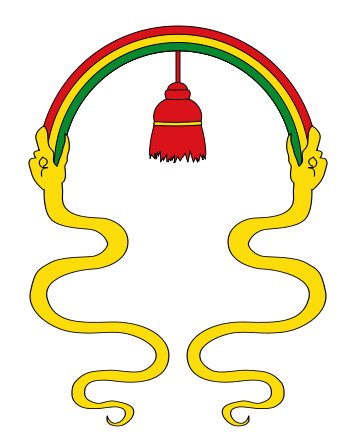The slender people were living to the west of the 'line of fire'. But they defeated the thick-set people living high up on Poike. Basically this division of the land seems to be rooted in a pattern with high in the east and low in the west, perhaps originating in South America:
... This illustration is from Ronald Wright, Cut Stones and Crossroads. A Journey in the Two Worlds of Peru. The 'pontificial world' (Pontifical Mundo) has Peru at the top and Spain at bottom, in both cases with the central edifices occupying the place of the Sun. Wright explains: [This is] Waman Puma's conception of the relationship between Peru and Spain according to the Andean duality principle of Hanan (Upper) and Hurin (Lower). Each country is shown as a Tawantinsuyu - four quarters with a capital in the center. Peru is higher, closer to the sun, and therefore full of gold, the 'sweat of the sun'. The topography of the Andes has morning Sun first shining on the mountain tops and the Upper Land (Hanan). Only later will the rays find the Lower Land (Hurin) down in the valleys and close to the sea in the west. I suggest there was a necessity involved. Those who lived high up on Poike were doomed by fate. If they were a separate people ('race') - and given that they really existed and were not only playing their part in a mythic theme - they had to be defeated at a certain time ('10h'). Because the pattern up in the sky was to be repeated down on land. This pattern of myth was wide-spread:
A quincunx is at left and then comes the 'Tree' making what is at left (in the past) a separate compartment of time. This Kingdom of Spring is different from the rest. Its duration can be described as 8 * 29½ = 236 nights (we can read from the 8 archs at the top). Beyond is a 'blanket' - a blank period of time - as if the position was down inside earth with no light available. Possibly the square cloth is a piece of sail (raa):
The Tree is partly hidden by the Cloth. To the right of the Cloth there is a pair of urns and below them a great circle with the night sky inside. We recognize features from the structure in the Taranaki storehouse, which also has a blank time-space immediately to the right of the apex. At the bottom of the Tree there is a peculiar 'helmet', maybe illustrating the 'cap' of the sky roof: ... The four males and the four females were couples in consequence of their lower, i.e. of their sexual parts. The four males were man and woman, and the four females were woman and man. In the case of the males it was the man, and in the case of the females it was the woman, who played the dominant role. They coupled and became pregnant each in him or herself, and so produced their offspring. But in the fullness of time an obscure instinct led the eldest of them towards the anthill which had been occupied by the Nummo. He wore on his head a head-dress and to protect him from the sun, the wooden bowl he used for his food. He put his two feet into the opening of the anthill, that is of the earth's womb, and sank in slowly as if for a parturition a tergo. The whole of him thus entered into the earth, and his head itself disappeared. But he left on the ground, as evidence of his passage into that world, the bowl which had caught on the edges of the opening. All that remained on the anthill was the round wooden bowl, still bearing traces of the food and the finger-prints of its vanished owner, symbol of his body and of his human nature, as, in the animal world, is the skin which a reptile has shed ...
(Inca banner.) |


